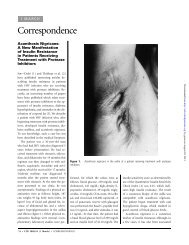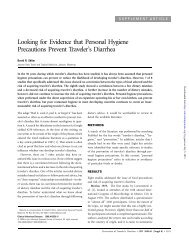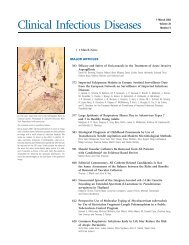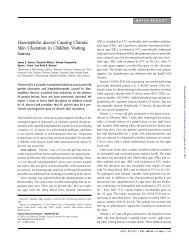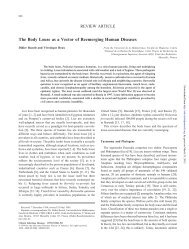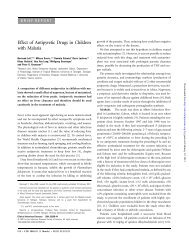open reading frame) in addition to the usual IS1016-bexA deletion ...
open reading frame) in addition to the usual IS1016-bexA deletion ...
open reading frame) in addition to the usual IS1016-bexA deletion ...
You also want an ePaper? Increase the reach of your titles
YUMPU automatically turns print PDFs into web optimized ePapers that Google loves.
Figure 1. The number of patients <strong>in</strong> each season surveyed by <strong>the</strong> date of onset of <strong>in</strong>fluenza A<br />
or <strong>in</strong>fluenza B. Percentages are <strong>the</strong> percentage of all seasonal cases of <strong>in</strong>fluenza attributable <strong>to</strong><br />
<strong>in</strong>fluenza B. Median, median date of epidemic, expressed as month/day.<br />
with use of <strong>the</strong> commercial rapid detection<br />
kits <strong>in</strong> <strong>the</strong> participat<strong>in</strong>g cl<strong>in</strong>ics throughout<br />
Japan between 10 November and 31 May<br />
every year. Figure 1 shows <strong>the</strong> date of onset<br />
and <strong>the</strong> number of cases of <strong>in</strong>fluenza A<br />
or <strong>in</strong>fluenza B that were diagnosed with<br />
<strong>the</strong> use of rapid detection kits dur<strong>in</strong>g <strong>the</strong><br />
past 5 <strong>in</strong>fluenza seasons. The <strong>to</strong>tal number<br />
of <strong>in</strong>fluenza A or <strong>in</strong>fluenza B cases, <strong>the</strong><br />
percentage of cases that are attributable <strong>to</strong><br />
<strong>in</strong>fluenza B, and <strong>the</strong> median date of <strong>the</strong><br />
epidemic <strong>in</strong> each season are also shown.<br />
The prevalence of <strong>in</strong>fluenza A was consistent<br />
<strong>in</strong> almost every year. However, <strong>the</strong><br />
prevalence of <strong>in</strong>fluenza B was variable season<br />
by season. The percentage of <strong>in</strong>fluenza<br />
cases attributable <strong>to</strong> <strong>in</strong>fluenza B was very<br />
small <strong>in</strong> <strong>the</strong> 2003–2004 and 2005–2006<br />
seasons (2.5% and 2.1%, respectively).<br />
However, <strong>in</strong> <strong>the</strong> 2004–2005 season, <strong>the</strong><br />
number of <strong>in</strong>fluenza B cases was more<br />
than twice <strong>the</strong> number of <strong>in</strong>fluenza A<br />
cases; <strong>the</strong> percentage of <strong>in</strong>fluenza cases attributable<br />
<strong>to</strong> <strong>in</strong>fluenza B was 67.8%. The<br />
high <strong>in</strong>cidence of <strong>in</strong>fluenza B dur<strong>in</strong>g <strong>the</strong><br />
2004–2005 season <strong>in</strong> Japan (also available<br />
on <strong>the</strong> Web site of <strong>the</strong> Infectious Disease<br />
Surveillance Center of Japan [3]) seemed<br />
<strong>to</strong> be un<strong>usual</strong>, as mentioned by Baum [1].<br />
We would also like <strong>to</strong> emphasize that<br />
all patients from whom we obta<strong>in</strong>ed <strong>the</strong><br />
date and time of <strong>the</strong> onset of fever, <strong>the</strong><br />
adm<strong>in</strong>istration of oseltamivir, and <strong>the</strong> resolution<br />
of fever were <strong>in</strong>cluded <strong>in</strong> <strong>the</strong> study,<br />
and no patients with <strong>in</strong>fluenza A or <strong>in</strong>fluenza<br />
B from whom we obta<strong>in</strong>ed <strong>the</strong>se data<br />
were excluded [2].<br />
In <strong>the</strong> 2004–2005 season, <strong>in</strong>fluenza A<br />
and <strong>in</strong>fluenza B were almost simultaneously<br />
prevalent (<strong>the</strong> median dates of <strong>the</strong><br />
epidemics were 27 February for <strong>in</strong>fluenza<br />
A and 21 February for <strong>in</strong>fluenza B). It<br />
seems <strong>to</strong> be important <strong>to</strong> differentiate patients<br />
with <strong>in</strong>fluenza A from patients with<br />
<strong>in</strong>fluenza B by use of commercial antigen<br />
detection kits, particularly dur<strong>in</strong>g seasons<br />
<strong>in</strong> which both types of <strong>in</strong>fluenza virus are<br />
simultaneously prevalent (such as <strong>the</strong><br />
2004–2005 season), because oseltamivir is<br />
less effective for <strong>the</strong> treatment of <strong>in</strong>fluenza<br />
B virus, as reported elsewhere [2, 4].<br />
Acknowledgments<br />
Potential conflicts of <strong>in</strong>terest. All authors: no<br />
conflicts.<br />
Naoki Kawai, 1 Hideyuki Ikematsu, 1,2<br />
Norio Iwaki, 1 Nobuo Hirotsu, 1 and<br />
Seizaburo Kashiwagi3 1Japan Physicians Association, Tokyo, and<br />
2<br />
Department of Cl<strong>in</strong>ical research, Hara-doi Hospital,<br />
and 3 Fukuoka Red Cross Blood Center,<br />
Fukuoka, Japan<br />
References<br />
1. Baum SG. Oseltamivir and <strong>the</strong> <strong>in</strong>fluenza alphabet.<br />
Cl<strong>in</strong> Infect Dis 2006; 43:445–6.<br />
2. Kawai N, Ikematsu H, Iwaki N, et al. A comparison<br />
of <strong>the</strong> effectiveness of oseltamivir for<br />
<strong>the</strong> treatment of <strong>in</strong>fluenza A and <strong>in</strong>fluenza B:<br />
a Japanese multicenter study of <strong>the</strong> 2003–2004<br />
and 2004–2005 <strong>in</strong>fluenza seasons. Cl<strong>in</strong> Infect<br />
Dis 2006; 43:439–44.<br />
3. Infectious Disease Surveillance Center of Japan.<br />
Weekly reports of virus isolation/detection<br />
2002/03–2006/07. Available at: https://hassei<br />
doko.mhlw.go.jp/Byogentai/Pdf/data2e.pdf.<br />
Accessed 20 September 2006.<br />
4. Kawai N, Ikematsu H, Iwaki N, et al. Fac<strong>to</strong>rs<br />
<strong>in</strong>fluenc<strong>in</strong>g <strong>the</strong> effectiveness of oseltamivir and<br />
amantad<strong>in</strong>e for <strong>the</strong> treatment of <strong>in</strong>fluenza: a<br />
CORRESPONDENCE • CID 2006:43 (1 November) • 1227<br />
Downloaded from<br />
http://cid.oxfordjournals.org/ by guest on March 21, 2013



